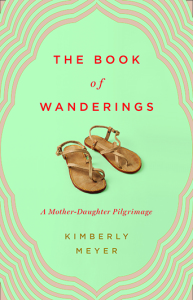What can we learn from Kimberly Meyer’s The Book of Wanderings?
May 1, 2015, by Sara Balabanlilar
A big congratulations to Kimberly Meyer, whose memoir The Book of Wanderings came out this March. Kim holds a PhD from the University of Houston Creative Writing Program, where she received an Inprint Brown Foundation Fellowship and an Inprint Michener Fellowship. Her work has recently appeared in The Best American Travel Writing, Ploughshares, The Kenyon Review, Ecotone, The Oxford American, The Georgia Review, Agni, The Southern Review, and Third Coast. She teaches in the Great Books program at the University of Houston Honors College. Here, Sara Balabanlilar, Kim’s student (and Inprint’s newest blogger) talks about The Book of Wanderings and what we can learn from it.
 Houston is a city filled with the angst of constant coming and going. Old buildings fall into disrepair and are easily replaced with three-story condos overlooking huge unused lots or old factories. Paved roads shift and crack in our sandy soil, which is persistent enough to keep any street too smooth for too long. The construction is endless here. All of these things lend to an air of constant change, of dissatisfaction with the space around us and the constant impetus to evolution and growth.
Houston is a city filled with the angst of constant coming and going. Old buildings fall into disrepair and are easily replaced with three-story condos overlooking huge unused lots or old factories. Paved roads shift and crack in our sandy soil, which is persistent enough to keep any street too smooth for too long. The construction is endless here. All of these things lend to an air of constant change, of dissatisfaction with the space around us and the constant impetus to evolution and growth.
 At first, Kimberly Meyer’s The Book of Wanderings seems to be in a similar vein of longing. In the first few pages, she describes an early trip to a chapel in New Mexico: “The chapel became a sign of what we were seeking in traveling with our daughters: remnants of something genuine that suburban sprawl had not yet swallowed up in its ravenous maw.”
At first, Kimberly Meyer’s The Book of Wanderings seems to be in a similar vein of longing. In the first few pages, she describes an early trip to a chapel in New Mexico: “The chapel became a sign of what we were seeking in traveling with our daughters: remnants of something genuine that suburban sprawl had not yet swallowed up in its ravenous maw.”
When Meyer’s small trips around the U.S. turn into a grander trip with her oldest daughter, Ellie, following the journey of a prolific medieval friar, her goal remains the same. She follows Felix Fabri’s journey as closely as she can, visiting chapels, churches, and pilgrimage sites just as he did. Her route starts near Fabri’s hometown of Ulm, then quickly moves into Italy, along the coast of eastern Europe, down through Greece into Israel and eventually Egypt. However, Meyer’s efforts to mirror Fabri’s tracks are undercut almost immediately, and regularly again throughout the trip. In Italy, she and Ellie get sick. Later, their guide through the desert turns out to have dubious plans for them. The idea of recreating perfectly a centuries-old pilgrimage path becomes imperfect. Continue reading

